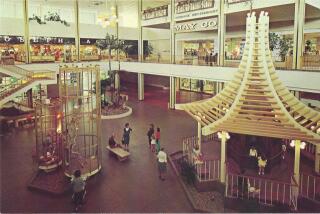Report Cards, Credit Cards Vie at the Mall : Children of retail workers to attend school, day care inside the huge shopping complex.
- Share via
BLOOMINGTON, Minn. — Starting next fall, as many as 500 public school students will likely find themselves attending classes in an unlikely building--the largest enclosed shopping mall in the United States.
Five Twin Cities-area school districts recently approved placing of classrooms inside the Mall of America, a 4.2-million-square-foot suburban Bloomington shopping complex due for August completion. The mall school would provide child care, preschool education, kindergarten through third-grade classes, high school work programs and adult education.
The youngest students will be the children of the estimated 10,000 Mall of America employees, parents who work at Bloomingdale’s, Macy’s, Nordstrom, Sears and 400 other stores. Or at Knott’s Camp Snoopy, a seven-acre amusement park. Or the LEGO Imagination Center, which showcases more than 30 LEGO models and a three-story LEGO crane. Or at a giant aquarium.
Partnerships between public schools and businesses have proliferated since 1987, when Florida’s Dade County schools began opening classrooms on the grounds of private companies. Probably every state has at least one such partnership, but the level of involvement varies greatly, said Melodye Bush, information specialist with the Education Commission of the States, a Denver-based interstate compact.
The concept usually involves the schools asking the corporate world to provide financial help, mentors for students or even physical space.
The Mall of America school will be unique because of its setting and the number of participating school districts, Bush said. “It’s impressive that they are establishing this school with the thought in mind of making school convenient for parents,” Bush said.
The idea of a public school in a giant shopping mall seems to have few detractors, but one Minneapolis Public Schools board member who voted against it worries that school-in-a-mall may promote runaway materialism.
“The propriety of putting an elementary school in a suburban shopping mall bothers me,” said board member David Tilsen. “The blatant consumerism. I’m not sure that’s what I want to encourage in our children.”
But the way Bush sees it, “Considering how much time children spend in the mall anyway, you might as well make it an educational experience.”
The missing piece of this experiment is money. The districts assume that state education dollars that would otherwise go to students’ home districts will be designated to follow students to their new schools. They are hoping the business community will pay for the construction of the school itself.
Since the school districts made their agreement in November, they have been out hustling funds to eventually build 40 or more schoolrooms out of about 40,000 square feet of raw space, which the Mall of America plans to offer at nominal rates. That could accommodate up to 1,000 students and would cost at least $2.5 million over several years. But the educators say businesses have responded, and they expect to announce initial donations soon.
The cooperating districts include Minneapolis, St. Paul and three suburban districts calling themselves the Metropolitan Learning Alliance. The new school would be run by a board of trustees, representing the five districts.
The Mall of America project would be only the latest and most ambitious among a half-dozen or so corporate schools that have cropped up in Minneapolis and St. Paul, in which companies pay for classroom space, maintenance and utilities.
In a new school begun in September, two Minneapolis-based companies, IDS Financial Services Inc. and Northern States Power Co., help pay the bills at the Downtown Open School. There in a downtown Minneapolis office building, some 53 kindergarten through second-graders attend classes in a giant white, purple and teal-colored room filled with schoolbooks, computers, aquariums, an art center and play area.
Two corporate school sponsors each contribute about $100,000 a year to cover the cost of amortizing construction costs and paying for rent and utilities.
Just 20 of the students are children of IDS and NSP employees. Many others are kids of other downtown workers.
The day before Thanksgiving, Ken Hirte, an IDS senior compensation consultant and father of a kindergartner, attended a celebration at the school. To get there he had only to walk across a downtown street.
“It’s working out really well,” said Hirte, who usually commutes by bus morning and night with his son. “That’s really extra time to interact. We can talk about his schoolwork or anything else.”
More to Read
Inside the business of entertainment
The Wide Shot brings you news, analysis and insights on everything from streaming wars to production — and what it all means for the future.
You may occasionally receive promotional content from the Los Angeles Times.










